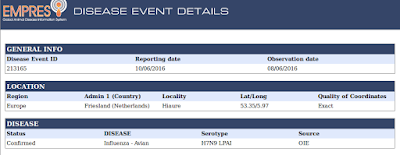UPDATED: Timing is everything. No sooner had I posted this entry when the following statement was published by AgriHolland News indicating this H7N9 is not related to the Asian H7N9 virus.
Bird flu P is low pathogenic subtype of Influenza A virus subtype H7N9The volgelgriepbesmetting on the laying farm in the Frisian Hiaure was further characterized. This shows that a low pathogenic subtype of Influenza A virus subtype H7N9 is not related to the Asian zoonotic virus type. That the Central Veterinary Institute of Wageningen UR announced on June 10.
#11,452
The bird flu outbreak I wrote about last week (see Netherlands: Likely LPAI H7 Outbreak In Hiaure) was identified over the weekend by the OIE/FAO as LPAI H7N9 - which as far as I know - is the first time this subtype has been reported in Europe.
Although this is the same subtype as the virus that has caused hundreds of human infections in China, it isn't at all clear that this is of the same lineage.
The subtype only identifies the virus's HA and NA surface proteins, and within each these there can be a great deal of genetic diversity, depending on its origins and evolutionary history. The source of a virus's internal genes can greatly influence its behavior as well.
So not all LPAI H7N9 viruses are necessarily the same.
Last December we saw the emergence of an HPAI H5N1 in France - but being of European lineage - it was determined not to pose the same threat to human health as the Asian H5N1.
We've not seen any characterization of this new H7N9 detection beyond the subtype, but so far we've not seen the kind of mobilization one would expect if this were the Asian strain.
Hopefully we'll get some clarification on the origins, and risks, of this virus in the next couple of days.
To date, the highly dangerous version of H7N9 has only been reported in China, but the day will likely come when that virus is discovered outside of their borders, carried in by wild and migratory birds.
On Saturday, in USGS : Experimental Challenge Of European Starlings With Avian H7N9, we looked at a study that suggests if China's H7N9 virus ever did make it to Europe, it wouldn't have much trouble finding suitable avian hosts.
